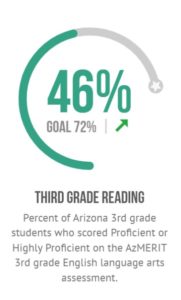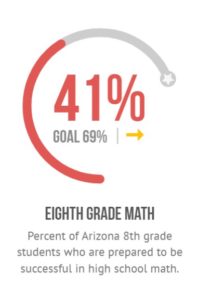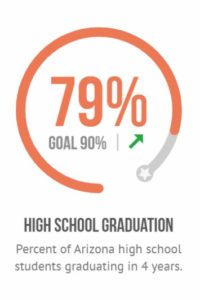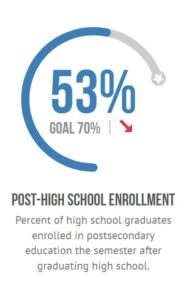
Federal Funding Creates Opportunity to Accelerate Change, Close Gaps in P-20 Education
Recent updates to the Arizona Education Progress Meter show that Arizona is not on track to meet our P-20 goals by 2030, and the data does not yet reflect the full effects of the pandemic. To meet the goals, we must rapidly accelerate change by closing achievement gaps and addressing educational inequities, which have been worsened by the pandemic. The influx of pandemic relief funds provides a tremendous opportunity to put us on a path to meet the Education Progress Meter goals by supporting the students who have been most affected by the pandemic, including students of color, those from low-income backgrounds, and students with disabilities. It also has the potential to help us further the funding priorities elevated in the Roadmap for P-20 Education Funding, which was based on the Education Progress Meter goals.
We reached out to our partners to ask for their best thinking about how these federal funds could be used to advance the Education Progress Meter goals. This letter includes recommendations from these 17 contributing organizations:
- Achieve60AZ
- ALL in Education
- Arizona Association of Teachers of Math
- Arizona Board of Regents
- Arizona Community College Coordinating Council
- Arizona Early Childhood Alliance
- Arizona Rural Schools Association
- Arizona School Administrators
- Arizona School Counselors Association
- Center for the Future of Arizona
- College Success Arizona
- Expect More Arizona
- Inclusive Strategies
- Read On Arizona
- State of Black Arizona
- UnidosUS
- Valley of the Sun United Way
Feedback from the field has indicated there are capacity issues in applying for funding, especially in small and rural schools. We encourage ADE to help eliminate barriers by allowing counties or other consortia of LEAs to jointly apply and to consider other delivery methods other than a traditional grant program.
Quality Early Learning | 3rd Grade Reading | 8th Grade Math | High School Graduation Rate | Opportunity Youth | Post High School Enrollment | Attainment | Teacher Pay | Cross-Cutting Issues
Quality Early Learning: Increase from 19% to 45% by 2030
The pandemic has had devastating effects on the access and availability of quality childcare and preschool. Now, one year into the pandemic, an estimated one-third of programs remain closed and 41% still have reduced capacity for the number of children they can serve. Additionally, with the loss of the federal Preschool Development Grant, Arizona lost over 3,000 quality preschool slots for 3 and 4-year-olds. Also, Kindergarten enrollment decreased approximately 14% this school year, which means that there will be a need to provide additional support to incoming Kindergarten students and coordinate the transition from early childhood or at home settings to school settings for the next school year.
- Invest in high-quality early learning by expanding access to early learning opportunities in high-needs areas and monitoring student progress as they enter Kindergarten.
- Implement and scale an approach that would replicate the successful Preschool Development Grant by braiding federal and state funds together.
- Allow early learning programs to extend the program year through the summer months and intercessions to offer comprehensive learning focused on the whole child.
- Provide additional academic support to incoming Kindergarten students who may not have engaged in learning opportunities during the pandemic. This could be accomplished with additional instructional aides, tutoring, family engagement or other strategies.
3rd Grade Reading: Increase from 46% to 72% by 2030
The pandemic’s impact on early literacy is not yet known, however, it is anticipated that the state may see a drop in proficiency. Arizona must act urgently to ensure that every child receives the support needed to be proficient in reading by the end of 3rd grade. Read On Arizona, the state’s early literacy initiative, calls for consideration of:
- Building educator capacity and the new teacher preparation pipeline to increase the knowledge of educators in the science of reading.
- Funding the coursework for educators to pursue and achieve a literacy endorsement in the science of reading.
- Providing funding to provide professional development in effective reading strategies for K-3 teachers.
- Deploying literacy coaches and intervention specialists to the lowest performing PK-3 schools.
- Funding the statewide Kindergarten entry assessment to better understand where students are when they begin the school year.
- Providing equitable access to supports and interventions to our unique populations (English Learners, SPED, Tribal, Economically Disadvantaged) to mitigate the learning loss faced during distance learning.
8th Grade Math: Increase from 41% to 69% by 2030
Student success in 8th grade math is an important milestone for student success in graduating from high school and pursuing college or a career. Like 3rd grade reading, the pandemic’s effect on this indicator is not yet fully known, however, the state should act now to mitigate any potential learning loss that students are experiencing in math across multiple elementary grades.
- Deploy math coaches and intervention specialists for grades K-5.
- Provide intensive tutoring for students in grades 6-8.
- Restructure the middle school math classroom by implementing quality, research-based curriculum and tools with a track record of improving outcomes for all learners, along with professional development and classroom coaching.
- Provide intensive professional development around the specialized content knowledge and pedagogical content knowledge for math, focused on teachers and their leaders.
High School Graduation: Increase from 79% to 90% by 2030
Arizona’s ratio of students to counselors must be improved if we want to see more students graduating from high school and pursuing postsecondary education or training. While hiring new counselors is not sustainable with one-time funding, it is worth mentioning as it was recommended as a need from multiple organizations contributing to this letter.
- Provide additional pay to school counselors whose students are now in greater need of academic and social and emotional support due to the pandemic. Use funds to recruit new and retain existing counselors that have an Arizona School Counselor certificate.
- Supplement school counselors with curriculum, materials, professional development to support students’ academic and social and emotional needs, especially the mental health issues that have risen due to the pandemic.
- Increase access to career information resources to elementary, junior high, and high school students.
- Develop and implement new approaches for college and career advising, such as co-advising and near peer mentoring models.
- Remove or provide flexibility for seat-time and credit-hour requirements to more easily allow work study and internship programs that provide alternate pathways to high school graduation.
- Expand access to Career and Technical Education programs in all areas of the state, including access to industry-certificated programs such as cloud computing, medical technology, welding, and other high-demand opportunities.
Opportunity Youth: Decrease from 12% to 7% by 2030
The current Education Progress Meter indicator does not yet incorporate 2020 data, which will better reflect the expected negative impact of the pandemic. It is anticipated Arizona will see an increase in the number of opportunity youth as a result of the pandemic. As a potential bellwether for this indicator, data for the greater Phoenix area has shown a significant spike in opportunity youth over the past six months (now 1 in 4 youth are disconnected from work and school). This is instructive as we consider the state as a whole.
- Scale up the number of re-engagement centers around the state to reconnect opportunity youth to education, work and wrap-around services.
Post-High School Enrollment: Increase from 53% to 70% by 2030
Students transitioning from high school to postsecondary education faced a number of pandemic-related challenges including a lack of access to school counselors, postsecondary options, and help applying for scholarships or financial aid. As a result, there has been a decline in postsecondary education enrollment over the past year due to the pandemic and a decline in the percent of students completing the FAFSA (32% this year vs 46% last year). It is critical that support be provided to students as they graduate from high school and pursue postsecondary education or training.
- Increase the number of Arizona high school seniors completing the FAFSA through an investment in tools like Ask Benji, the first AI-powered FAFSA chatbot, focused on supporting high school seniors’ path to postsecondary, which could be ramped up to serve all high school seniors in the state.
- Fund matching commitments and provide other supports for programs like AdviseAZ (AmeriCorps) to supplement the capacity and work of school counselors to provide robust and equitable college and career counseling for all Arizona students.
- Provide funding for bridge programs for students who are under-prepared for college, but college bound, to bring them to university campuses the summer before their freshman year (sometimes even the summer before senior year of high school) to assist with basic college preparation skills. Expanding these programs would allow broader student participation.
- Expose students of color to postsecondary education options early and often, including through high-school-to-college transition programs, early college enrollment programs, and through targeted advising.
- Provide funding to create a campaign that builds a college-going culture among students of color to promote paths to postsecondary education and clearly articulates the value of postsecondary attainment.
- Increase student access to dual enrollment, which provides a pathway to attainment for many students.
Attainment: Increase from 46% to 60% by 2030
The road to 60% attainment starts through the earliest years of the education pipeline. It also will depend on how Arizona is able to support students of color and create pathways to attainment.
- Incentivize postsecondary institutions to increase attainment of students of color through financial investment, public recognition, or other means.
- Fund career training opportunities, such as internships and apprenticeships, around community needs and where persons of color are underrepresented in the local workforce.
- Provide funding to study and disseminate research on the predictive behaviors that contribute to postsecondary attainment for students of color.
- Funding new and expanded reskilling and upskilling programs at community colleges for incumbent workers while also maximizing their training and education capacity to get more people into better paying jobs, including the establishment of a Technology and Innovation Workforce Development Fund managed by the ACA/OEO in partnership with Arizona’s community colleges–this fund will simultaneously address specified economic development priorities, workforce needs of employers seeing to relocate or expand in Arizona, and the upskilling/reskilling needs of incumbent workers.
- Expedite the development of the Integrated Data System (State Longitudinal Data System) to combine administrative data from various state agencies and educational institutions.
- Fund the creation of the Arizona Advanced Technology Network that would create a unified certificate program, universally recognized by all Arizona community college partners.
- Expand regional career-connected pathways to increase educational attainment, grow future career opportunities for students, and meet regional talent needs.
- Expand the development and implementation of career-connected pathways into regions and specific communities most impacted by the pandemic. Infrastructure to design and deliver this exists through the Arizona Pathways to Prosperity Initiative and Network.
- Support planning grants for school districts and charter schools to improve post school outcomes for students with disabilities.
Teacher Pay: Increase from 50th in the nation to 25th by 2022
The inclusion of teacher pay in the Arizona Education Progress Meter was a proxy for supporting teacher recruitment and retention. While we have made gains in teacher pay, more than half of other states have too, which makes it more difficult for Arizona to be competitive. A long-term solution to increasing teacher pay to the national median is still necessary and is supported by a majority of voters across all parties. While the federal coronavirus relief programs are one-time funding and cannot be used for teacher salaries, they can be used to support activities including to support teacher recruitment and retention by:
- Providing additional pay to recruit or retain teachers, to teachers/staff that have assumed new duties due to COVID, and for substitute pay.
- Investing in programs and services that support teacher mental health and well-being.
- Providing trauma informed teaching supports.
- Directing funding to recruit teachers of color into the teaching profession to better reflect the communities they serve.
- Providing statewide, meaningful professional development, mentoring and induction that are research-informed, driven by best practices and support inclusive practices.
Cross-Cutting Issues
The organizations contributing to this letter offered the following recommendations that span multiple Education Progress Meter indicators and would accelerate recovery from the pandemic.
Social-Emotional Support
As the result of the pandemic, students have experienced trauma that has affected their mental health.
- Dedicate funding to provide behavioral and social/emotional support for students in this and next school year through curriculum, professional development (e.g. scaling up Project AWARE), student peer mentoring programs, and the creation or expansion of public/private partnerships to deliver counseling services.
- Provide trauma-informed approaches for staff, families, and children such as: professional development, mental health consultation, instructional supplies, social-emotional curricula, staff wellness activities, mental health support for staff, parenting education and family supports.
Instructional Time
Addressing learning loss will be a process that will require a focused effort for multiple years. Schools have many tools in their toolboxes to be able to help students catch up, including instructional time. Schools should have the ability to make decisions about instructional time at the district or school level to best meet the needs of their students.
- First, ensure that existing instructional time is used in the most effective ways possible.
- Then expand learning time for schools who determine it would be the most effective way to support their students’ success, which could be accomplished in different ways (e.g. after school, summer learning, extended days, longer learning blocks, etc.). ADE can play an effective role by offering and supporting flexibility (through things like reporting, providing clarity on regulations, and other activities) that would LEAs to allow schools to best meet the needs of their students.
Technology Access
The use of technology will continue beyond the pandemic. In fact, the integration of digital learning will likely continue to have a strong presence in education for the foreseeable future. As we’ve learned during the pandemic, however, student access to technology has been insufficient.
- Provide students access to devices, a reliable Internet connection, and provide communities with broadband capabilities.
- Ensure parents and families have computer literacy skills that would help their child navigate online learning platforms and communicate with their schools is also critical to address.
- Invest in rural broadband access.
Tribal Education
Supporting our American Indian students is reflected throughout this document, which should be complemented with the following suggestion:
- Provide funding to schools with high concentrations of American Indian students to implement comprehensive language revitalization programs and to the Office of Indian Education to support implementation.
Students with Disabilities
Students with disabilities have been particularly challenged by COVID-related school closures and the corresponding lack of predictability and consistency. The influx of new one-time funds could be used to support unique, game-changing initiatives that will prioritize inclusion and accelerate innovation. Supporting our students with disabilities is reflected throughout this document, which should be complemented with the following:
- Create a targeted fund for innovation in special education which prioritizes efforts to increase and support inclusion and postsecondary outcomes.
- Leverage the additional IDEA funds to launch an innovation network devoted to students with disabilities and develop ways to help schools pursue all available flexibilities in both state and federal law and funding sources.
- Make a one-time infusion of funds to support early education by expanding the Preschool Inclusion Coaches program currently administered through First Things First. These coaches train and support childcare providers so they can prepare children with disabilities for a successful transition to kindergarten—an area where some families struggled because of the pandemic.
- Use new, one-time funds to examine the outcomes of the students exempted from Arizona’s successful Move On When Reading initiative, many of whom have disabilities. Through a one-time study of district and charter schools, the state can explore the data and support schools as they develop new program and policy recommendations to ensure all children learn to read.
- Fund seed grants for community colleges to partner with local high schools to increase access dual enrollment for students with disabilities.
Parent and Family Engagement
Support opportunities to increase capacity of parents and family members to engage in supporting their child’s education. The pandemic gave many families a window into their child’s education that they had not previously had before. As students shifted to learn from home, expectations for how parents engage also shifted overnight, requiring more of their support for their child’s academic success.
- Support programs that build parent capacity and knowledge for how to support their child’s education experience and build a strong 1-1 relationship with their child’s teachers. ALL in Education’s Parent Educator Academy and Read On Arizona’s Virtual Family Engagement Center are two examples of these types of programs.
- Create tangible resources for parents and families to support their child’s educational experience.
Personalized Learning
Many Arizona teachers and school leaders are looking to personalized, mastery-based learning as an effective strategy proven to address learning loss by meeting each student at their own level, challenging them with high expectations for academic achievement, and growing student agency and ownership of their own learning. The urgency for this approach is especially great for schools serving low-income families and students of color, who are disproportionately impacted by the effects of the pandemic.
- Invest one-time funds to provide a continuum of timely quality professional learning and support to help K-12 teachers and school leaders effectively make the shift to personalized learning at the classroom, building, and district/charter network level. Infrastructure to design and deliver this exists through the Arizona Personalized Learning Network led by the Center for the Future of Arizona.
These recommendations offer opportunity to strategically allocate the COVID relief funding to advance the goals in the Arizona Education Progress Meter. To learn more about the Education Progress Meter, visit ExpectMoreArizona.org/Progress.






